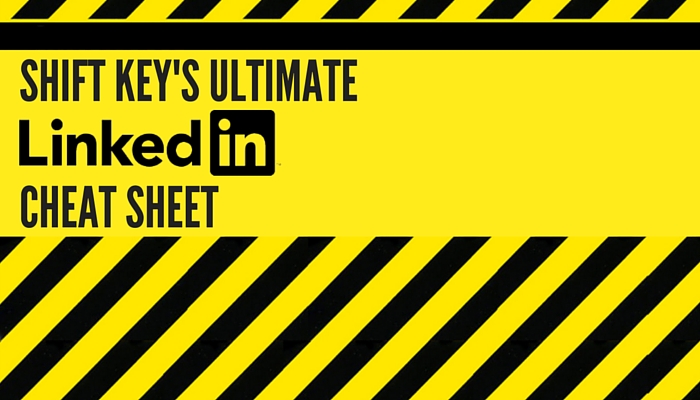LinkedIn is the world’s largest professional network, and last month, we shared the first round of tips to max out its potential for your business.
To unlock our full list of things you may have not known about LinkedIn — the ultimate CliffsNotes cheat sheet — keep reading!
1) GO ALL-STAR: Whereas other social media platforms may encourage the use of emoticons and slang, it should go without saying that all LinkedIn content should be free from typos and grammatical errors — professional in all senses. Your profile should also be completed fully. When you log in to LinkedIn, you’ll see a “profile strength” indicator on the right-hand side. By simply following their suggestions for profile completeness, you can rise to their top designation of “All-Star.” Users with completed profiles are 40 times more likely to receive opportunities through LinkedIn. Click here to see what constitutes a “complete” profile.
2) KEYWORDS, not buzz words: “Motivated,” “responsible” and “creative” were the most used words on profiles in 2014, 2013 and 2012, respectively. Instead of throwing in overused buzz words, include keywords that align with your objectives. Seek fresh ways to connect keywords with well written text. Sprinkle keywords in your summary and under each “experience” entry as well. If you want to transition from an operations manager in the shipping industry to a human resources specialist, for example, you might trade out the words “logistics” or “warehouse management” in your last two job descriptions to rather focus on your efforts with “recruitment” or “risk management.”
3) ENDORSEMENTS: Introduced in late 2012, the revamped “Skills & Endorsements” section seems here to stay. It may seem annoying that LinkedIn constantly asks you to “endorse” a connection for a skill that seems a no-brainer in your industry. (“Sure, I’ll check ‘yes’ that our social media manager is knowledgeable about social media.”) But keep in mind that only first-degree connections can endorse you. In other words, when people you know well say good things about you — in public — it can only add to your credibility. To make endorsements more useful however, you can and should hide any that do not reflect your current goals, under the “Manage Endorsements” section. You can guide connections by initially listing your “skills,” which they can then endorse on your behalf. Simply populating the skills portion of this section can yield 13 times more profile views.
4) RECOMMENDATIONS: Experts suggest at least two to three recommendations. While recruiters say they wouldn’t necessarily exclude a candidate for not having recommendations, they seem to agree they can help push an already strong resume’ over the edge. Because recommendations are more personal and specific than the endorsements section, they should be considered as important to your brand as client testimonials are to a company’s. Instead of just asking coworkers, also include clients if applicable. When you request a recommendation, make the job easier for them by providing some keywords or a brief summary to remind them of your experience working together. Offer to return the favor by providing recommendations to your reviewers as well.
5) CONNECT: This one seems a no-brainer, and yet, even if you have the perfect profile, you are missing the entire point of LinkedIn if you don’t connect. Seek out a relevant and abundant network of contacts. You can organically add contacts, searching through locations, schools you attended, former employers, or one of up to 50 professional interest “groups” you can join. Or you can import contacts from Yahoo, Gmail or a .CSV file. The convenience is that clicking a button should be less awkward than attending a business networking mixer or alumni fundraiser event. The goal isn’t just to create connections to reach out when you need something, though. The idea is to build a healthy list of first-degree connections and communicate with them periodically to maintain the relationship.
6) COMMUNICATE & NURTURE: The LinkedIn news feed, rebranded as LinkedIn Pulse which became a stand-alone app in mid-2015, facilitates these goals with articles written by everyone from human resources pros or social media consultants to a list of LinkedIn “INfluencers” — business gurus like Richard Branson, Arianna Huffington, Deepak Chopra and more. Follow, like or share others’ posts, provide thoughtful comments and expand your connections and industry insights. Publish an original article about something that would be of interest to your connections.
7) CLOSING THE DEAL: In addition to all of the above ideas for strengthening your personal brand or company, think about how you can grow your company with LinkedIn as well. With 433 million users, it can be a goldmine for HR recruiters, depending on the industry. With over 33,000 corporate customers on LinkedIn, it’s also a rich resource for sales and marketing professionals. When you email people via LinkedIn, it can legitimize your outreach. Perhaps you have connections in common or went to the same grad school. Plus, the email recipient can easily cross reference your resume’ by viewing your profile.
LinkedIn is responsible for more than 80 percent of a business’ social media leads. That’s four times more than all the other social media sites combined (19.67 percent). You can easily export your contacts’ names and email addresses to integrate them with communication efforts aside from LinkedIn.
As a content marketing and PR agency, Shift Key has included LinkedIn writing services for executives and their corporate pages in our various packages. Click here to contact us for more information.

